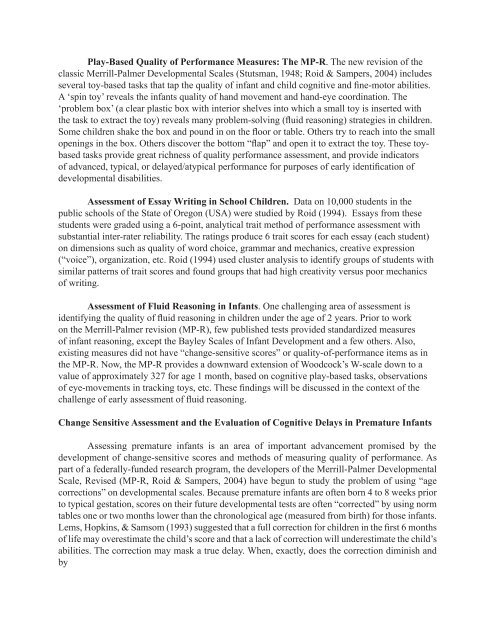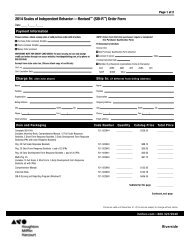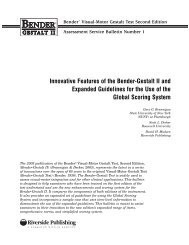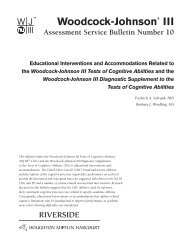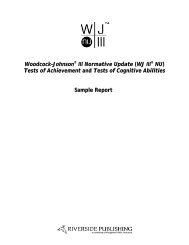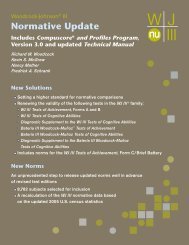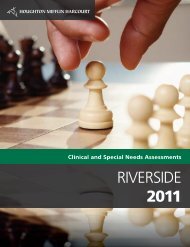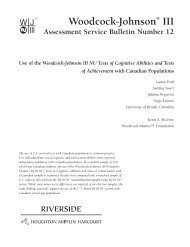Quality of Performance and Change-Sensitive ... - Nelson Education
Quality of Performance and Change-Sensitive ... - Nelson Education
Quality of Performance and Change-Sensitive ... - Nelson Education
You also want an ePaper? Increase the reach of your titles
YUMPU automatically turns print PDFs into web optimized ePapers that Google loves.
Play-Based <strong>Quality</strong> <strong>of</strong> <strong>Performance</strong> Measures: The MP-R. The new revision <strong>of</strong> theclassic Merrill-Palmer Developmental Scales (Stutsman, 1948; Roid & Sampers, 2004) includesseveral toy-based tasks that tap the quality <strong>of</strong> infant <strong>and</strong> child cognitive <strong>and</strong> fine-motor abilities.A ‘spin toy’ reveals the infants quality <strong>of</strong> h<strong>and</strong> movement <strong>and</strong> h<strong>and</strong>-eye coordination. The‘problem box’ (a clear plastic box with interior shelves into which a small toy is inserted withthe task to extract the toy) reveals many problem-solving (fluid reasoning) strategies in children.Some children shake the box <strong>and</strong> pound in on the floor or table. Others try to reach into the smallopenings in the box. Others discover the bottom “flap” <strong>and</strong> open it to extract the toy. These toybasedtasks provide great richness <strong>of</strong> quality performance assessment, <strong>and</strong> provide indicators<strong>of</strong> advanced, typical, or delayed/atypical performance for purposes <strong>of</strong> early identification <strong>of</strong>developmental disabilities.Assessment <strong>of</strong> Essay Writing in School Children. Data on 10,000 students in thepublic schools <strong>of</strong> the State <strong>of</strong> Oregon (USA) were studied by Roid (1994). Essays from thesestudents were graded using a 6-point, analytical trait method <strong>of</strong> performance assessment withsubstantial inter-rater reliability. The ratings produce 6 trait scores for each essay (each student)on dimensions such as quality <strong>of</strong> word choice, grammar <strong>and</strong> mechanics, creative expression(“voice”), organization, etc. Roid (1994) used cluster analysis to identify groups <strong>of</strong> students withsimilar patterns <strong>of</strong> trait scores <strong>and</strong> found groups that had high creativity versus poor mechanics<strong>of</strong> writing.Assessment <strong>of</strong> Fluid Reasoning in Infants. One challenging area <strong>of</strong> assessment isidentifying the quality <strong>of</strong> fluid reasoning in children under the age <strong>of</strong> 2 years. Prior to workon the Merrill-Palmer revision (MP-R), few published tests provided st<strong>and</strong>ardized measures<strong>of</strong> infant reasoning, except the Bayley Scales <strong>of</strong> Infant Development <strong>and</strong> a few others. Also,existing measures did not have “change-sensitive scores” or quality-<strong>of</strong>-performance items as inthe MP-R. Now, the MP-R provides a downward extension <strong>of</strong> Woodcock’s W-scale down to avalue <strong>of</strong> approximately 327 for age 1 month, based on cognitive play-based tasks, observations<strong>of</strong> eye-movements in tracking toys, etc. These findings will be discussed in the context <strong>of</strong> thechallenge <strong>of</strong> early assessment <strong>of</strong> fluid reasoning.<strong>Change</strong> <strong>Sensitive</strong> Assessment <strong>and</strong> the Evaluation <strong>of</strong> Cognitive Delays in Premature InfantsAssessing premature infants is an area <strong>of</strong> important advancement promised by thedevelopment <strong>of</strong> change-sensitive scores <strong>and</strong> methods <strong>of</strong> measuring quality <strong>of</strong> performance. Aspart <strong>of</strong> a federally-funded research program, the developers <strong>of</strong> the Merrill-Palmer DevelopmentalScale, Revised (MP-R, Roid & Sampers, 2004) have begun to study the problem <strong>of</strong> using “agecorrections” on developmental scales. Because premature infants are <strong>of</strong>ten born 4 to 8 weeks priorto typical gestation, scores on their future developmental tests are <strong>of</strong>ten “corrected” by using normtables one or two months lower than the chronological age (measured from birth) for those infants.Lems, Hopkins, & Samsom (1993) suggested that a full correction for children in the first 6 months<strong>of</strong> life may overestimate the child’s score <strong>and</strong> that a lack <strong>of</strong> correction will underestimate the child’sabilities. The correction may mask a true delay. When, exactly, does the correction diminish <strong>and</strong>by


